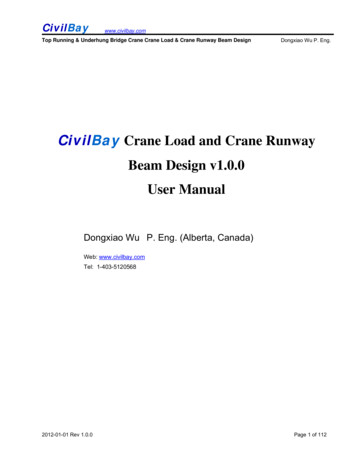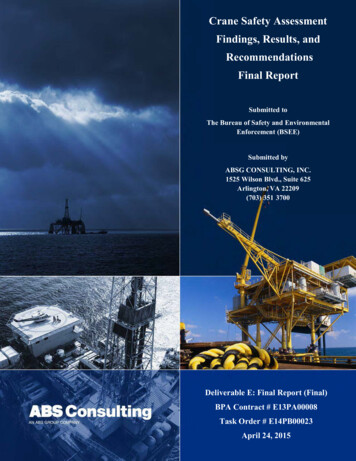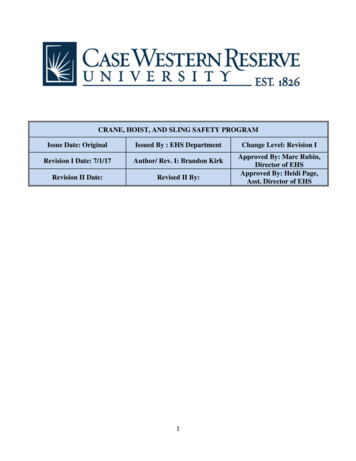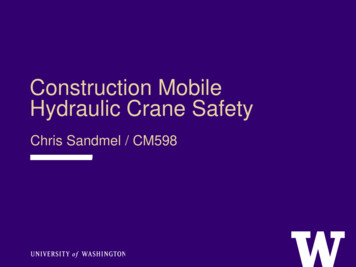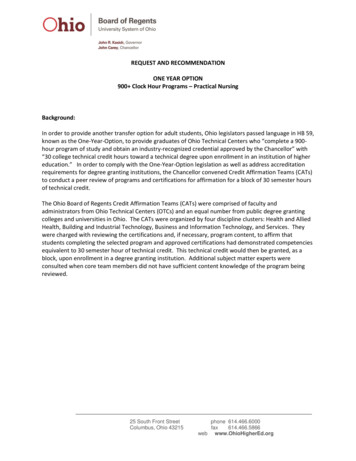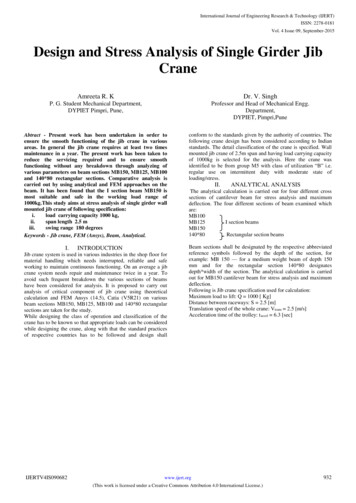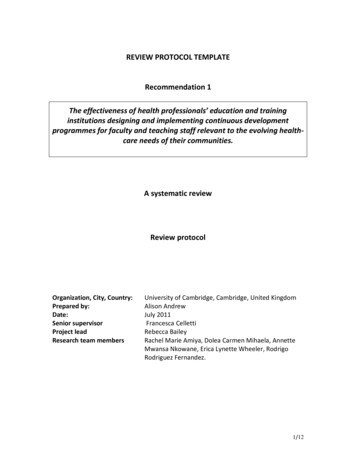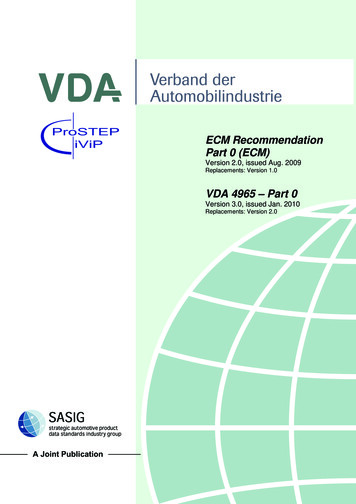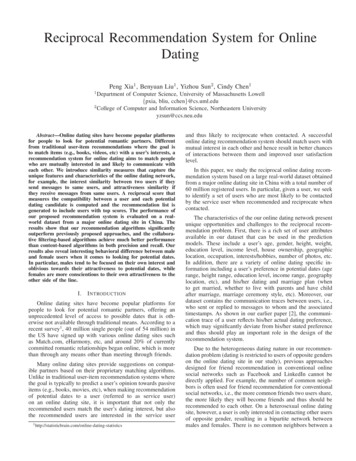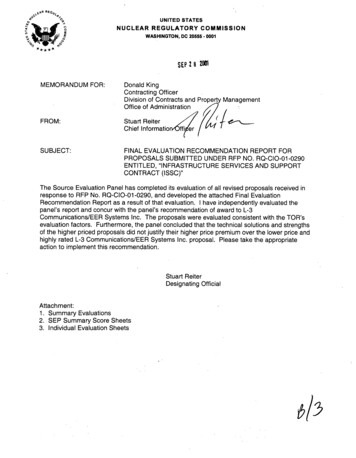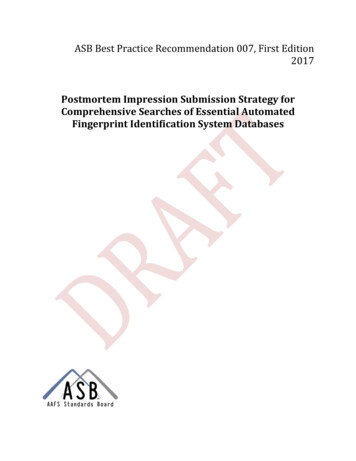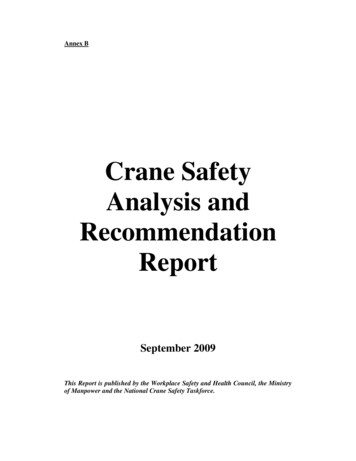
Transcription
Annex BCrane SafetyAnalysis andRecommendationReportSeptember 2009This Report is published by the Workplace Safety and Health Council, the Ministryof Manpower and the National Crane Safety Taskforce.
EXECUTIVE SUMMARYBackground1.In 2008, there were 162 crane-related fatalities, injuries and dangerousoccurrences, a 27% increase from 128 cases in 2007. While most of the casesinvolve less serious non-fatal injuries, crane incidents can potentially lead tomassive and severe damage to both physical properties and human lives.Objective2.The primary objectives for this report are to:a)Identify the major contributing factors for the collapse of cranes40 investigated cases1 of past crane incidents were analysed using the5M model (i.e. Man, Machine, Medium, Management & Mission) andseveral major reasons for the collapse of cranes were identified.b)Make recommendations to improve safety of crane operationsRecommendations and suitable changes/improvements to improvesafety of crane operations were made from lessons learnt through the40 cases.Findings of the Crane Safety Analysis and Recommendation ReportSummary of Analysis3.Using the 5M model, Man, Medium, Machine and Management were found tohave contributed to the collapse of cranes.4.Among the 40 cases studied, Man was identified as a contributing factor for 23cases. The main concern in this area is the violation of safety rules andregulations by individual workers. This includes bypassing limit switches,ignoring warning alarms as well as failing to check load charts and complywith safe work procedures. Other concerns include unintentional humanerrors and the lack of knowledge / information on the weight of the load beinglifted.5.Machine was a factor in 14 of the cases where machine components failed tofunction properly. The most common component failures are wire ropes andlimit switches. Two reasons identified were the lack of maintenance and theimproper use of cranes (e.g. using cranes of wrong capacity).6.Medium, such as ground stability, was a factor in 9 cases. This includesgrounds that were too weak or too inclined to support crane operations safely.1Report were provided by Ministry of Manpower
Annex BGround stability can also be affected by changes in weather (such as heavyrainfall) and by other ongoing works such as excavation in its vicinity. Safetymeasures such as the adequate use of steel plates and constant monitoring ofground conditions were found lacking in these cases.7.Finally, Management was identified in 25 out of the 40 cases studied. Thevarious ways in which Management contributed to these crane collapsesinclude the lack of site assessment, inadequate supervision (refers mainly tolifting supervisor), lack of established and implemented safe work procedures,as well as the lack of worker training.8.This Report also identified Management as a key factor affecting safeoperation of cranes. Besides contributing directly to the largest number ofcases, it also played an influential role in the other 3 factors. It had directcontrol over the amount of supervision and training provided for the workers,which affected the Man factor. In addition, the responsibility of having regularmaintenance for the crane and conducting site assessments (which greatlyinfluenced the Machine and Medium factors respectively) lies onManagement. Thus Management plays an important role in keeping our cranessafe.Improvement areas identified9.Based on the analysis of the contributing factors, several improvement areaswere identified in this Report.10.To address the tendencies for Man to engage in unsafe acts, it is important tohave proper supervision. and to conduct behaviour audit checks to identifyand tackle these unsafe behaviours before they lead to an incident. Craneoperators must be properly informed of the load’s weight and the crane’scapacity before commencing any lifting operations. All personnel should beadequately trained and briefed before work. An efficient fatigue managementsystem must also be in place.11.The failure in Machine components highlights the need to ensure that allcranes are properly and regularly maintained. Record of the crane’smaintenance history must be kept for reference, when needed. The industrymust also make routine checks on the functionality of the crane prior to anylifting operation with particular attention for safety devices such as limitswitches and warning alarms.12.On the issue of Medium, it is important to conduct a proper site assessment toensure that the ground can safely support the required crane operation beforework commence. An assessment should also be carried out after any changein weather condition. If the ground condition is deemed to be unsafe orunsuitable for crane operation, Management must locate an alternative suitablesite or undertake sufficient safety measures such as placement of adequatesteel plates over the soft ground.
Annex B13.Management must ensure that risk assessment is conducted prior todeveloping any safety measures. This would identify all potential hazards(e.g. soft ground condition) and methods to eliminate or reduce them. Thesesafe work procedures must be developed by competent personnel. Theseprocedures are to be communicated to and adhered by personnel involved inthe crane operation.Management must also ensure there is adequatesupervision during the crane operation and that all personnel are properlytrained.Recommendations by National Crane Safety Taskforce14.Based on this Report, the National Crane Safety Taskforce, the WorkplaceSafety and Health Council (WSHC) and the Ministry of Manpower (MOM)have made recommendations to address issues related to Man, Machine,Medium and Management. The recommendations are broadly classified inthree areas – training, outreach and reviewing Codes of Practice.15.On training, the Taskforce will work with WSHC and MOM to improve thecurrent training content of various mandatory courses for lifting operations.These courses will be reviewed in consultation with the industry, whereappropriate. To improve the quality of delivery of the training courses onlifting operation, MOM will also strengthen the surveillance on its AccreditedTraining Providers (ATPs). There is also a proposal to leverage on thenational WSQ framework for consistency in training provision andcompetency of the trainees.16.On enhancing outreach efforts, the Taskforce will work with WSHC andMOM to establish appropriate joint programmes to engage top management,upstream crane manufacturers and downstream crane operators. A riskregister for lifting operation will also be developed. Platforms to send cranesafety messages will include newsletters for stakeholders and forums.17.On review of Codes of Practice, the Taskforce, with WSHC and MOM, willparticipate in the review of relevant Codes of Practice, such as the CP62:1995Code of Practice for the Safe Use of Tower Cranes. In addition, a fact sheeton Maintenance Programme is also being planned.Conclusion18.This Report marks the start of the Taskforce’s work to improve the safety ofcrane operations. The Taskforce will further develop its recommendations andan implementation plan. It will also review relevant legislations and explorenew technology to enhance safe lifting. The Taskforce will provide updateson its plans and progress in early 2010.
Annex BContent Page1.Introduction.11.1 Background .11.2 Present Legal Requirements .21.3 Objectives of This Crane Safety Analysis and Recommendation Report .22.Research and Analysis .32.1 Definitions.32.1.1 Cranes .32.2.2 Collapse of cranes .32.2 Fault Tree Analysis .42.3 Contributing Factors Leading to Collapse of Cranes at Workplace .52.4 Analysis of Identified Contributing Factors .62.4.1 Man .62.4.2 Machine.82.4.3 Medium .102.4.4 Management.122.4.4.1 Management (supervisor) .122.4.4.2 Management.133.Summary of Analysis.143.1 Man .143.2 Machine.143.3 Medium .143.4 Management.144.Improvement areas identified .154.1 Man .154.2 Machine.154.3 Medium .164.4 Management.165.Recommendations by National Crane Safety Taskforce .175.1 Enhancement of Training.175.2 Enhancement of Outreach Efforts.175.3 Review of Codes of Practice.176.Conclusion .18
Annex BList of FiguresFigure 1: Number of workplace incidents involving cranes for 2007 and 2008 .1Figure 2: Distribution of 5M factors leading to collapse of cranes .5Figure 3: Reasons to why Man resulted in the collapse of cranes .6Figure 4: Overloading in Man factor leading to collapse of cranes.7Figure 5: Collapse of crane due to overloading .7Figure 6: Different Types of Component Failure .8Figure 7: Improper use of crane.9Figure 8:Break down of the 9 incident cases where Medium is a contributingfactor .10Figure 9: Collapse of crane due to soft ground condition.10Figure 11: Reasons Management contributed to the collapse of cranes.12
Crane Safety Analysis and Recommendation Report1.Introduction1.1BackgroundAs illustrated in Figure 1 below, the total number of injuries and dangerousoccurrences involving crane increased from 128 in 2007 to 162 in 2008, an increaseof almost 27%.No. of Workplace Incidents involving Cranes,2007 and 20081501209060300Workplace Fatalities(involving cranes)Dangerous Occurrence (DO)Non-Fatal Workplace Injuriesinvolving Collapse, Failure or(involving cranes)Over-turning of Cranes20074107172008513918Figure 1: Number of workplace incidents involving cranes for 2007 and 2008Even though most of the increase came from non-fatal injury cases, it is important tonote that crane incidents can potentially cause massive and severe damage to bothphysical property and human lives. In addition, the use of cranes is extensive acrossmany workplaces, with more than 17000 cranes registered.Hence, the increase is a matter of concern and there is a need to analyse craneincidents and recommend appropriate prevention measures.Please note that the information provided is not exhaustive and for the benefit of enhancingworkplace safety and health so that a similar recurrence may be prevented. The information 1provided is not to be construed as implying any liability to any party nor should it be taken toencapsulate all the responsibilities and obligations of the reader of this Report under the law.
Crane Safety Analysis and Recommendation Report1.2Present Legal RequirementsThe following legal requirements relating to operations of cranes are currently inplace:1)2)3)4)5)Workplace Safety and Health Act (Chapter 354A)Workplace Safety and Health (General Provisions) RegulationsWorkplace Safety and Health (Construction) RegulationsWorkplace Safety and Health (Shipbuilding and Ship-repairing) RegulationsFactories (Operations of Cranes) Regulations (will be replaced by WorkplaceSafety and Health (Operation of Cranes) Regulations)Relevant codes of practice are as follow:1) Singapore Standard SS 536:2008 Code of Practice for the Safe Use of MobileCrane2) Singapore Standard CP 62:1995 Code of Practice for Safe U
5M model (i.e. Man, Machine, Medium, Management & Mission) and several major reasons for the collapse of cranes were identified. b) Make recommendations to improve safety of crane operations Recommendations and suitable changes/improvements to improve safety of crane operations were made from lessons learnt through the 40 cases. Findings of the Crane Safety Analysis and
